|
□ What are Verification Procedures?
“Verification Procedures” are the procedures in which Customs makes a decision as to whether the suspected goods are infringing IPRs or not.
(Paragraph 1 of Article 69-12 of the Customs Law, Article 62-16 of the Order for Enforcement of the Customs Law)
1. The Flow of Verification Procedures (for imports)
|
|
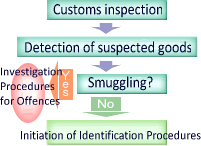
|
When Customs detects suspected goods in the course of physical inspection on imports of general cargoes (sea and air) or postal items, Verification Procedures are initiated unless the case is subject to Investigation Procedures for Offences
|
|
 |
|
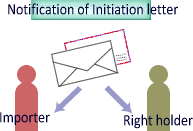
|
When suspected goods are detected, Customs notifies both importers and right holders of the initiation of Verification Procedures by providing them respectively with relevant information such as names and addresses of parties concerned.
The producer's names and addresses are also notified to right holders if they are obvious in the import declaration form, etc. which has been submitted to Customs.
|
|
 |
|
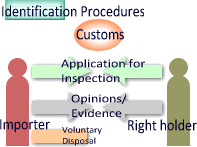
|
Both right holders and importers are provided with equal opportunities to submit their opinions and evidence to Customs within 10 working days (3 working days for perishable items) from the day following the date of the “Notification of Initiation” letter.
In the cases based on approved applications for suspension, each party may inspect goods during Verification Procedures
Applicants may also conduct “Sample Examination” (i.e. dismantlement, analysis), on the condition that all the requirements for approval for “Sample Examination” are satisfied and the security is provided.
Importers may take a measure of “Voluntary Disposal” (e.g. destruction, abandonment, reshipment, obtaining consent from the right holder, removal of infringing parts.) In the case of either consent from right holders or removal of infringing parts, Customs makes a decision of no infringement. In the other cases, Customs discontinues Verification Procedures.
|
|
 |
|
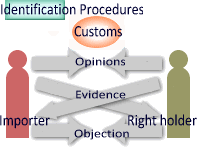
|
Opinions and evidence from one party are disclosed to the other party for submitting additional opinions, etc. Based on opinions and evidence from both parties, Customs makes a decision as to whether the suspected goods are infringing IPRs or not (decisions are expected to be made within one month).
|
|
 |
|
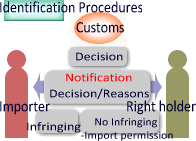
|
To notify the result of the Verification Procedure, “Notification of Decision” letter is sent to both right holders and importers. If it is decided that the goods are not infringing IPRs, an import permit is granted.
If it is decided that the goods are infringing IPRs and no measures of voluntary disposal have been taken during the period for protest (for two months), Customs may confiscate and destroy the infringing goods.
|
|
|
|
2. The Flow of Simplified Verification Procedures(limited to the Application for Suspension other than patent rights, utility model rights, and design rights)
If the importer does not submit any written objections to Customs about the “Notification of Initiation” during the designated period in the procedure, Customs makes an infringement decision based on information in the applications for suspension without asking any further opinions and evidence from parties concerned. (Article 62-16 of the Order for Enforcement of the Customs Law) |
|

|
When Customs detects suspected goods in the course of physical inspection on imports of general cargoes (sea and air) or postal items, Verification Procedures are initiated unless the case is subject to investigation for offence.
|
|
 |
|

|
When suspected goods are detected, Customs notifies both importers and right holders of the initiation of Verification Procedures by providing them respectively with relevant information such as names and addresses of parties concerned.
“The Notification of Initiation (Confirmation of Importer's Objection)” to importers also explains that objections from importers may be submitted in writing within 10 working days from the day following the date of receipt of such notification.
The producer's names and addresses are also notified to right holders if they are obvious in the import declaration form, etc. which has been submitted to Customs.
|
|
 |
 |
|

|

|
|
(1) Cases where no objections have been filed by importers Customs makes a decision as to whether the suspected goods are infringing IPRs or not based on the approved applications for suspension from right holders (i.e. the application form and the attached documents).
If it is decided that the goods are not infringing IPRs, an import permit is granted.
If it is decided that the goods are infringing IPRs, Customs sends a “Notification of Decision” to right holders, and a “Notification of Decision (Confiscation) to importers for notification.
Neither protests nor contact has been made by importers within three months from the day following the date of receipt of such notification, Customs may confiscate and destroy the infringing goods unless no measures of voluntary disposal have been taken.
|
(2) Cases where objections are filed by importers Customs notifies both importers and right holders of the deadline to submit opinions and evidence.
Each party should submit opinions and evidence with respect to the suspected goods to Customs within 10 working days (3 working days for perishable items) from the day following the date of the Notification. (Following procedures are the same as 1.(The Flow of Verification Procedures (for imports)) above.)
|
|
|
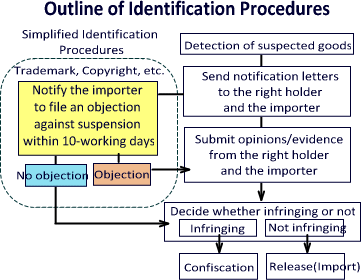
|
|
|
|









![Customs Channel[YouTube]](/mizugiwa/chiteki/english/common/img/banner-youtube.jpg)

